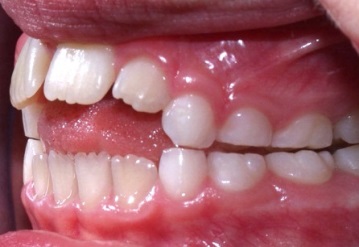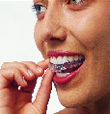
Consider the braces that you or your children might have worn at some point. Traditional orthodontists are trained to make the teeth look pretty. Basically their job is just to straighten your teeth. In some cases, they may even pull out a few teeth if those teeth make it harder to make the other teeth look straight. At our office, we consider the other effects that the placement of your teeth can have. Where your teeth are located affects how you bite, and how you bite affects how much tension you have in your jaw, which in turn affects how much stress you feel, your posture, your strength, and other health factors. Additionally, when your teeth form too narrow of a channel for your tongue and palate, you can develop bad breathing and snoring habits. Many children and adults have needed to get braces a second time under the guidance of a well educated dentist to undo these undesired side effects.
We treat all types of patients from little children to teens to adults with different types of orthodontic procedures. Our goal is to get it right the first time and place your teeth in a position where the risk of the teeth shifting out of position or relapsing is minimized and the jaw joint (TMJ) is in a healthy position for life.
Children's Orthodontics

There are amazing things that can be done while children still have baby teeth and are developing. With today's diet and industrialized air environment, deficiencies in the growth and development of the upper and lower jaws has unfortunately become common place. Luckily, a lack of proper bony development can be treated early and minimize the need for braces in the future. Things that would require jaw surgery if left until the child was older, such as an underbite "bull dog bite" or the anterior open bite (as shown in this picture), can oftentimes be completely reversed with early intervention.
Usually at this stage, treatment is started with an appliance that the child wears that may expand the bone in one or many directions or may bring the lower jaw into its correct position. Whenever possible we use devices that are bonded into place so that the parents and the doctors don't need to worry about the child losing or not wearing their appliance. This helps keep compliance from being an issue.
Teenage Orthodontics

Once the jaws have been properly developed and most of the baby teeth have been lost, it is time for braces! This is an exciting time for the parents, the doctors and the teens. This is when the magic happens and the beautiful smile is created.
The length of time that braces will be needed varies from person to person. Usually you can assume that the braces will be needed for less time if proper skeletal expansion and jaw relationship has already been established (See Children's orthodontics). If you weren't able to get orthodontics started before the teenage years, don't worry! Most young teens are still growing and therefore we can still get most of the bone and jaw development that they need. It will mean a little longer time in braces, but the results are worth it!
Adult Orthodontics

It's never too late to get the smile of your dreams!
With clear braces or Invisalign, adults are getting their teeth straightened more often than ever.
Neuromuscular Functional Orthodontics

Braces to get rid of headaches, migraines, neck problems, face and joint pain? This is a very meticulous form of orthodontics that cannot be reliably achieved by the untrained traditional orthodontist. For patients who want braces and are experiencing headaches, face or jaw pain, grinding or other symptoms, we start with a neck and jaw repositioner that is bonded on top of your lower teeth. We follow up with a succession of treatments until your computerized muscle testing and jaw tracking results are good and you are feeling great. We then methodically move your teeth into that exact position where you are comfortable.
Essentially, we find the exact position that your jaw and neck need to be in and then support that position with your teeth by moving them into that specific position. No long term orthotic appliances needed. No guess work.
See our TMD/Headache page for more information or visit our before/after page to see the results or our Testimonial page to hear what patients have to say.
Invisalign

Invisalign is a great choice in cases where minimal movement is desired or if traditional braces are not an option. With Invisalign, you wear a succession of clear, plastic "aligners" until the desired result is accomplished.
It's easy and predictable!
FAQs about Orthodontics
Why are straight teeth important?
Never underestimate the value of a powerful smile. It is not only beautiful, but first and foremost, it promotes optimal health:
- Teeth that are straight and evenly spaced are easier to keep clean, leading to better oral health. Better oral health can reduce the incidence of heart disease, gastrointestinal disease and other health conditions.
- Teeth that are properly aligned chew more efficiently, and that aids in proper digestion.
- Teeth that are straight and properly aligned create a more perfect bite, and that avoids excessive stress, headaches and strain on your supporting bone and tissue.
The social benefits of a beautiful smile are also important:
- Confidence – in job interviews, public speaking and personal relationships.
- Clearer speech – teeth play an important role in your ability to speak.
At what age should an orthodontic screening be done?
Really it is much more than the teeth that need to be checked. It is also the growth and development of the maxilla (upper jaw), the mandible (lower jaw) and the associated airway space. It is important to have an initial developmental screening done between the ages of three and four. Certain treatments start about age four.
Will I need to have teeth extracted for braces?
The removal of certain teeth historically has been a common practice. Because removing teeth tends to make a smaller arch for your teeth to fit within, the jaws are not developed sufficiently and tongue and airway space are compromised. Research now shows that this can have detrimental long term health effects including a higher risk of developing Temporomandibular dysfunction (TMD) and sleeping issues such as sleep apnea. Cosmetic issues are also a concern since the underdeveloped jaws can leave facial deficiencies including the appearance of a flattened upper lip, smaller lips, bigger nose, double chin or "weak chin" (retruded chin).
How long will it take to complete treatment?
Treatment time can vary significantly and depends on each patient's specific orthodontic problem. In general, treatment times range from 12 to 30 months. The "average" time frame a person is in braces is approximately 18 months. This time does not include the first phase, if needed.
How much will braces cost?
It is impossible to give a cost estimate for treatment until we have examined you. We will cover the exact cost and financial options during the initial examination. We have financing options available to accommodate your needs, and we will review these with you. We will also review your dental benefits policy and help to maximize your benefit and file your claims.
How often will I have appointments?
Appointments are scheduled according to each patient's needs. Most patients in braces will be seen every 4-8 weeks. If there are specific situations that require more frequent monitoring, we will schedule appointments accordingly. Special techniques can be provided so that time lines can be accomodated for patients that travel long distances.
Do braces hurt?
Generally, braces do not "hurt." After braces are first placed on the teeth, patients should expect soreness for the first few days. In these situations, over-the-counter pain medications, such as Advil or Tylenol, and warm salt water rinses will ease the discomfort. We also recommend wearing orthodontic wax when necessary. However, after most follow-up visits, patients do not feel any soreness at all!
Are there foods I cannot eat while I have braces?
Yes. Once treatment begins, we will explain the complete instructions including a comprehensive list of foods to avoid. Some of those foods include: ice, hard candy, raw vegetables and all sticky foods (i.e. caramel and taffy). You can avoid most emergency appointments to repair broken or damaged braces by carefully following our instructions. During the first week of braces, we recommend soft, highly nutritious foods for patient comfort.
What is Invisalign?
Invisalign is an alternative way to straighten teeth and improve smiles. Using patented medical imaging technologies, Invisalign manufactures clear aligners that rapidly straighten teeth.
Does insurance cover Orthodontics/Braces?
Some patients find they have a limited amount of dental benefits that can be applied toward orthodontics. You can find out if you have these benefits by calling your dental benefit plan ("insurance provider") or looking in the explanation of benefits book that companies provide for their subscribers. If you have dental benefits that help with orthodontic treatment, any type of orthodontics should qualify.
How else can I get help for Orthodontics?
We offer flexible and affordable in-house payment plans for up to twelve months as well as longer term financing through Meritrust's Lifestyle Lending. Depending on where you work, many companies allow pre-tax contributions to be set aside in a Flexible Spending Account (FSA). Orthodontic treatment is considered a qualified treatment that can be reimbursed using your FSA.
Why should I choose Dr. Gill for my Orthodontic treatment?
Dr. Gill has had extensive training in the art and science of occlusion and orthodontics. Occlusion is the relationship between the upper and lower teeth when the jaw is closed and their surfaces come in contact. Orthodontics is not just about creating straight teeth; it is also about establishing a healthy, long-lasting position for the neck, jaw and teeth. Crooked teeth often result in excessive wear to teeth that can result in a variety of long-term problems. Dr. Gill understands the importance of function and aesthetics.
Is it required that I have a referral from my primary dentist or physician?
No, it is not. Many of our patients are referred by their primary health provider, yet many other patients are referred from other health professionals and current patients.
